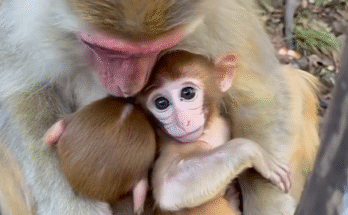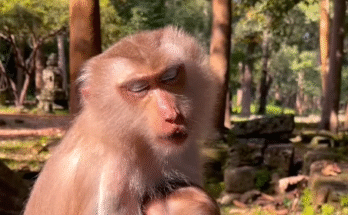The sun was barely up when I heard the sound — faint, high-pitched cries coming from somewhere in the dense trees near the river. At first, I thought it was a bird, but the tone was different, almost pleading. Curiosity pulled me toward the sound, and soon, I found myself pushing through vines and branches, following the desperate calls.
That’s when I saw him.
A tiny monkey, no bigger than my forearm, crouched at the base of a tree. His fur was patchy, his ribs visible beneath his skin, and his big, round eyes glistened with fear. He looked lost, alone, and too weak to climb. My heart twisted at the sight. Somewhere in the forest, this little one should have been clinging to his mother, learning to leap from branch to branch. Instead, he was here on the ground, vulnerable to predators and the elements.
I knelt a few feet away, careful not to scare him. “Hey, little guy,” I said softly. “It’s okay.”
He didn’t run — maybe because he couldn’t. His tail twitched weakly, and he let out another small cry. I knew I had to help. Moving slowly, I pulled a piece of banana from my backpack and held it out. His eyes followed the fruit, and after a moment of hesitation, he crawled forward, took it in his tiny hands, and nibbled. The way he ate — frantic but careful — told me he hadn’t had a real meal in days.

I wrapped him gently in a soft cloth I carried for my camera gear and cradled him against my chest. He was light as a feather, but I could feel the faint tremble in his body. Back home, I set up a small basket lined with warm towels and placed him inside. He sat up, clutching the towel like a safety blanket, watching me with cautious eyes.
I gave him water in a shallow lid and offered more banana, then mashed up a boiled egg for extra protein. He ate slowly this time, as though starting to trust that the food wouldn’t vanish.
For the first night, I kept him in my room so I could hear if he cried. Sure enough, around midnight, I woke to soft whimpers. I got up, picked him up, and gently rocked him the way you might comfort a human baby. His small fingers curled around mine, and gradually, his breathing slowed. It was in that moment I realized — this little monkey had no one left. I didn’t know what had happened to his family, but I knew I couldn’t let him go back to being alone.
The next morning, I called the local wildlife rescue center to explain the situation. They thanked me for helping and said they could take him in — but warned that rehabilitating a baby monkey was delicate work. I agreed to bring him in the following week, but part of me already dreaded the thought of saying goodbye.
Over the next few days, I learned just how intelligent and sensitive monkeys are. The little one, whom I named Milo, followed me everywhere — from the kitchen to the garden. He would cling to my shirt when I walked, and if I sat down, he’d climb onto my shoulder or curl into my lap. When he was happy, he made a soft chattering sound, and when something startled him, he’d press his face into my arm until he felt safe again.
Bath time was an adventure. Milo didn’t mind warm water, but he hated soap. I had to gently rinse him with my hands while he clung to me, his little tail wrapped around my wrist. Afterward, I would wrap him in a towel, and he’d bury his face in it like a shy child.
Each day, I could see him growing stronger. He started climbing small branches in my yard, testing his balance. He played with bits of rope I hung up for him, swinging clumsily at first, then with more confidence. Watching him gain strength and curiosity filled me with pride, but also a bittersweet feeling — I knew he belonged in the wild, not in my house.
One afternoon, as we sat under the mango tree, I caught him staring at the forest beyond the fence. His eyes followed the movements of birds and the rustle of leaves. I could almost feel the pull of his natural home calling him back.
When the day came to take him to the rescue center, I packed a small basket with his towel and some fruit for the journey. Milo sat quietly, his little hands gripping my fingers as we drove. The rescue staff greeted us warmly and checked his health. They said he was underweight but otherwise in good condition — thanks to the care he’d received.
They assured me he would be placed with other young monkeys so he could learn how to socialize and survive in the wild. Eventually, when he was ready, they would release him back into the forest.
As I handed him over, Milo looked at me with those same big eyes I had seen the first day. He let out a soft sound — not quite a cry, but almost a question. I stroked his head and whispered, “You’re going to be okay, little one. This is where you belong.”
Leaving the center without him was harder than I expected. The house felt quieter, emptier. I kept glancing at the corner of the room where his basket had been, half-expecting to see him there.
Weeks later, I received an update from the rescue. Milo had bonded with another orphaned monkey and was thriving. He had gained weight, was climbing like a pro, and was even learning to forage for his own food. They sent a picture — Milo swinging from a branch, eyes bright and full of life.
I smiled through tears. That tiny, fragile creature I had found on the forest floor was now on his way to becoming a strong, independent monkey.
The experience taught me something profound: sometimes, helping means letting go. I couldn’t keep Milo forever, but I could give him the second chance he deserved. And though he was no longer with me, a part of my heart would always belong to that poor baby monkey I found crying alone in the forest.



